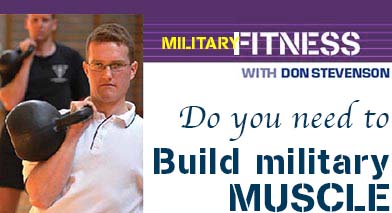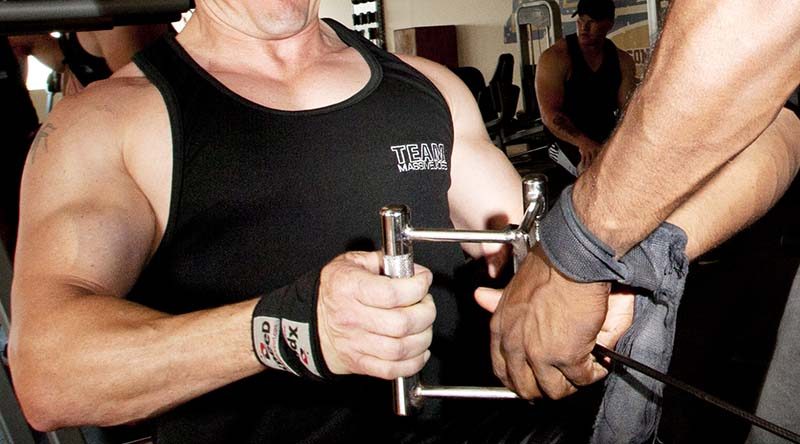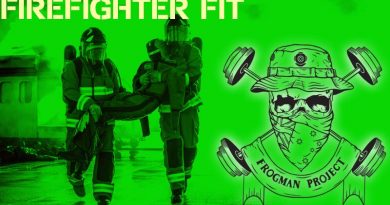Military muscle – Part I


In this two-part article I want to address the subject of training for increased muscle mass and how this type of training fits into the overall spectrum of military fitness.
In part one we’ll look at some of the considerations that military personnel need to take into account before deciding whether or not it is necessary or appropriate to embark on a muscle-building program, as well as some of the myths that persist about training for mass.
In part two I’ll lay out some guidelines for building mass in the military-fitness environment.
.
Things to consider first
Most people whether civilian or military, understand that muscle mass is important for sports performance and that, in general, more muscular people are stronger than their non-muscular counterparts.
What many people fail to realise is that there is far more to the story than that. Depending on the requirements of your job or sport, there is an optimum level of muscle mass and, muscle mass and strength are not as closely related as you would think.
 Couch to Commando by Don Stevenson is a 165-page e-book with programs in 6 different levels to progress anyone from couch potato to commando candidate.
Couch to Commando by Don Stevenson is a 165-page e-book with programs in 6 different levels to progress anyone from couch potato to commando candidate.
20% of proceeds from the sale of this e-book will be donated to Soldier On
Increased muscle mass hinders running ability: There are no world-class marathon or middle-distance runners who weigh 100kg or even 90kg. Physiology and physics dictates that, as your overall mass increases, it takes more and more energy to move that mass at a certain speed, and the size of the average heart and lungs limits how much oxygen is available to supply that energy.
Big is not strong, only strong is strong: If all other factors are equal, the strength of a muscle is directly related to its cross-sectional area. However, it is quite possible for two muscles with the same size to produce vastly different force outputs. The difference in strength between two muscles is a combination of structural factors and the efficiency with which the muscle fibres are recruited by the nervous system. This is commonly seen in a comparison between bodybuilders and strength athletes. Often, the bodybuilder is more muscular but weaker than the lifter (although don’t think that bodybuilders are weak!)
Strength-to-weight ratio: In the military, power-to-strength-to-weight ratio is king. It is good to be strong, but if that comes at the expense of being able to move quickly and get yourself over obstacles, then even a 400kg deadlift is a liability. For each role in the Defence Force there are different requirements and, before deciding whether or not you need to add muscle mass, you should analyse the requirements of your job and decide how much strength is useful and if there will be negatives to adding mass.
.
Muscle building myths
Before I outline my recommendations and some sample programs in part two of this article I want to cover off a few of the myths about muscle-mass training that refuse to die.
Myth 1: You can build muscle mass quickly without gaining bodyfat.
Err, no. It would be awesome if this were true. More pills and powders are sold with this promise than just about anything else on the Internet. But, I hate to break it to you – putting on muscle mass is HARD and putting on mass while staying lean is almost impossible. If you are eating enough to gain muscle you will inevitably gain some fat as well.
Myth 2: Lifting weights makes women bulky and unattractive.
Sorry ladies but you can’t weasel out of lifting with this stupid excuse. Putting on mass is hard enough for guys, but for women it is even more difficult. If you see a woman who looks like a man, it is because she is probably taking steroids and is, hormonally at least, more man than woman. Strength training and adding some muscle mass is the best thing most women can do for their fitness and, as a bonus, it is extremely effective for reducing bodyfat levels.
Myth 3: X number of reps or sets causes muscle growth.
This one is partially true. There are certainly rep and set ranges that are better for building muscle mass – however, there are other factors that are far more important (which I will cover in part two). If anyone tries to sell you a ‘magic program’, then they don’t understand training well enough to be offering real advice.
Myth 4: You need to take a pre-workout, intra-workout shake, post-workout recovery shake, testosterone booster, mass gainer and 14 different vitamins and herbs to add mass.
Sports supplements are a multi-billion-dollar industry, mostly built on a huge lie and lashings of placebo effect. The reality is that the number of effective supplements is extremely limited (and, fortunately, fairly affordable) and wasting hundreds of dollars on the latest protein powder or pre-workout is only making someone else’s bank account bigger – but not your muscles.
.
In part two of this article I am going to outline my general recommendations for muscle-building plans and provide some recommendations on exercise selection, diet and supplements.
.
.
.
.

.
.






